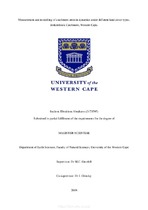| dc.description.abstract | Several attempts have been made to assess the impact of post-fire soil erosion; however, erosion occurs as a result of the complex interplay between many factors, such as climate, land cover, soil and topography, making precise estimation difficult. Additionally, these factors are far from constant in space and time, and often interact with one another. To assess the impact of wildfire on soil erosion and factors influencing its variability, the post-fire soil erosion response of two mountainous headwater sub-catchments namely Langrivier and Tierkloof, with different vegetation cover in the Jonkershoek Valley was examined using a systematic approach that combines efforts in field and laboratory work, spatial analysis and process-based numerical modelling. Geospatial modelling shows high spatial variability in erosion risk, with 56 % to 67 % of surfaces being highly susceptible excluding rock cover. The model highlights the importance of terrain and vegetation indices, with predicted erosion being more severe on steep slopes with lower vegetation cover. | en_US |

